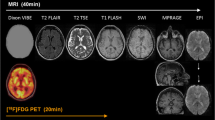Abstract
Purpose
Positron emission tomography (PET) is a functional neuroimaging method that maps brain activity non-invasively. Statistical methods play an essential part in understanding and analysing functional PET data. Several Bayesian approaches have been proposed for neuroimaging techniques that arrange information on the brain structure or activity function. In this paper, Bayesian analysis was used to detect functional brain activity in single- and multiple-subject PET data.
Methods
Free PET dataset analyses for a single subject and five multiple subjects were conducted. A total of 72 functional PET images were processed, 12 for each one of the five multiple subjects and for the single subject. Several ways to design multiple-subject PET data were introduced in this work. Bayesian analysis was performed on the five multiple-subject and the single-subject PET data. A comparison was presented to determine which statistical matrix design is applicable for brain detection activity in PET data.
Results
The results of the design matrix and brain activity detection were presented for each selected design matrix. The Bayesian estimation of each case of the PET dataset for all the subjects was plotted. The brain activity was plotted as voxels on a transparent brain image in three orthogonal planes. The voxels were visualised using the maximum intensity projection method.
Conclusion
Results showed that brain activity could not be detected easily in single-subject PET data. Finding the activity in multiple subjects depended on the design matrix used for PET data analysis.




Similar content being viewed by others
References
Aabha Dixit. Nuclear medicine for diagnosis and treatment. Office of Public Information and Communication Editor; 2017. https://www.iaea.org/sites/default/files/nuclear-medicine-for-diagnosis-and-treatment.pdf. Accessed 27 May 2020.
Ashburner J, Barnes G, Chen C-C, Daunizeau J, Flandin G, Friston K, et al. SPM12 manual: the FIL methods group (and honorary members). 2020. https://www.fil.ion.ucl.ac.uk/spm/doc/spm12_manual.pdf. Accessed 27 May 2020.
Bailey DL, Karp JS, Surti S. Physics and instrumentation in PET. In: Bailey DL, Townsend DW, Valk PE, Maisey MN, editors. Positron emission tomography: basic sciences. London: Springer-Verlag; 2005. p. 13–39.
Blodgett TM, Mehta AS, Mehta AS, Laymon CM, Carney J, Townsend DW. PET/CT artifacts. Clin Imaging. 2011;35(1):49–63.
Cantalupo C, Hopkins WD. Asymmetric Broca’s area in great apes: a region of the ape brain is uncannily similar to one linked with speech in humans. Nature. 2001;414(6863):505.
Castellaro M, Rizzo G, Tonietto M, Veronese M, Turkheimer FE, Chappell MA, et al. A Variational Bayesian inference method for parametric imaging of PET data. NeuroImage. 2017;150:136–49.
Deutsch S. Bayesian brain: probabilistic approaches to neural coding (Doya, K., Eds., et al.; 2007) [Book Review]. IEEE Pulse. Institute of Electrical and Electronics Engineers (IEEE); 2010;1(3):64–5.
Frackowiak RSJ, Ashburner JT, Penny WD, Zeki S. Human brain function. 2nd ed. Friston KJ, Frith CD, Dolan RJ, Price CJ, editors. Elsevier Academic Press; 2004.
Karl J Friston, Will Penny. Classical and Bayesian inference. Academic Press; 2004;911–68.
Hanson KM. Introduction to Bayesian image analysis. 1993. https://kmh-lanl.hansonhub.com/publications/medim93.pdf. Accessed 27 May 2020.
Hermans E. SPM8 starters’ guide. 2011. http://www.ernohermans.com/wp-content/uploads/2011/11/spm8_startersguide.pdf. Accessed 27 May 2020.
Kennison SM. Introduction to language development. 1st ed. SAGE Publications, Inc; 2013.
Kinahan PE, Noll DC. A direct comparison between whole-brain PET and BOLD fMRI measurements of single-subject activation response. NeuroImage. 1999;9(4):430–8.
Pettinato C, Nanni C, Farsad M, Castellucci P, Sarnelli A, Civollani S, et al. Artefacts of PET/CT images. Biomedical Imaging and Intervention Journal. 2006;2(4):e60.
Phillips PR. Bayesian statistics, factor analysis, and PET images I. Mathematical background. IEEE Trans Med Imaging. 1989;8(2):125–32.
SPM-statistical parametric mapping. 1991. https://www.fil.ion.ucl.ac.uk/spm/. Accessed 27 May 2020.
Sureshbabu W, Mawlawi O. PET/CT imaging artifacts. Journal of Nuclear Medicine Technology. 2005;33(3):156–61.
Wallis JW, Miller TR, Lerner CA, Kleerup EC. Three-dimensional display in nuclear medicine. IEEE Trans Med Imaging. 1989;8(4):297–30.
Woolrich MW, Jbabdi S, Patenaude B, Chappell M, Makni S, Behrens T, et al. Bayesian analysis of neuroimaging data in FSL. NeuroImage. 2009;45(1 Suppl).
Wright JD. International encyclopedia of the social and behavioral sciences. 2nd ed. Elsevier; 2015.
Zhang L, Guindani M, Vannucci M. Bayesian models for functional magnetic resonance imaging data analysis. Wiley Interdisciplinary Reviews: Computational Statistics. Wiley-Blackwell; 2015;7(1):21–41.
Zhou Y, Aston JAD, Johansen AM. Bayesian model comparison for compartmental models with applications in positron emission tomography. J Appl Stat. 2013;40(5):993–1016.
Author information
Authors and Affiliations
Corresponding author
Ethics declarations
Ethical approval
This article does not contain any studies with human participants or animals performed by the author.
Conflict of interest
The author declares that she has no conflict of interest.
Additional information
Publisher’s note
Springer Nature remains neutral with regard to jurisdictional claims in published maps and institutional affiliations.
Rights and permissions
About this article
Cite this article
Aljobouri, H.K. Brain activity detection in single- and multi-subject PET data by Bayesian analysis. Res. Biomed. Eng. 36, 303–309 (2020). https://doi.org/10.1007/s42600-020-00071-x
Received:
Accepted:
Published:
Issue Date:
DOI: https://doi.org/10.1007/s42600-020-00071-x




